Volvo 740 1988 Owner Manual
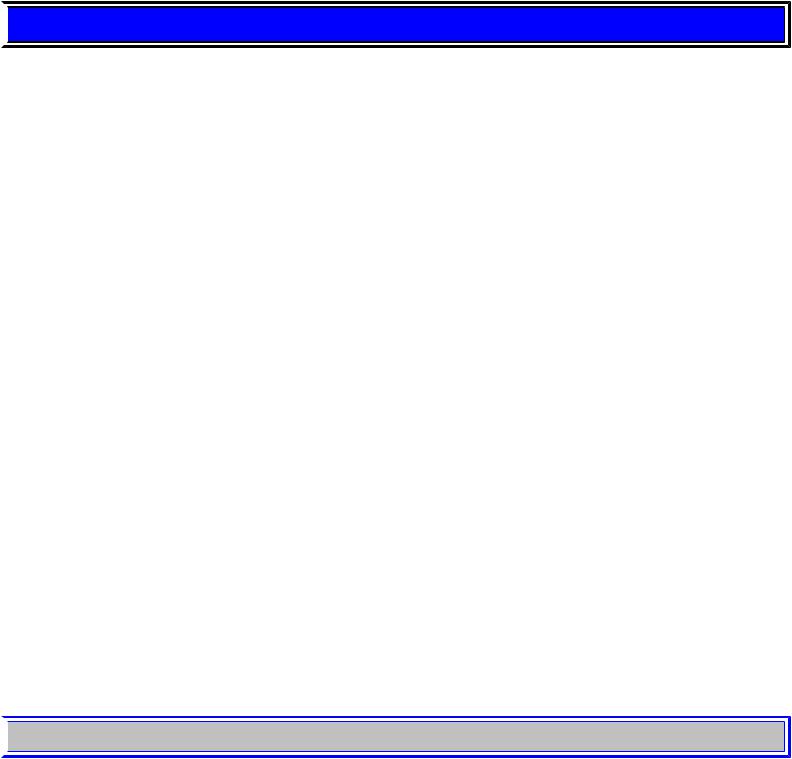
1988 Volvo 740
1 9 8 8 VOLVO 740
 Contents
Contents
A comprehensive index is located at the back of this manual.
Presentation
Instruments and controls
Body and interior
Starting and driving
Wheels and tires
In case of emergency
Car care
Service and routine maintenance
Specifications
Index
SRS Addendum
All information, illustrations and specifications contained in this manual are based on the latest product information available at the time of publication. Volvo reserves the right lo make model changes at any time, or to change specifications or design. without notice and without incurring obligation.
 pg. 2 Presentation
pg. 2 Presentation
file:///K|/ownersdocs/1988/1988_740/88740_00.htm (1 of 3)12/30/2006 8:20:20 AM
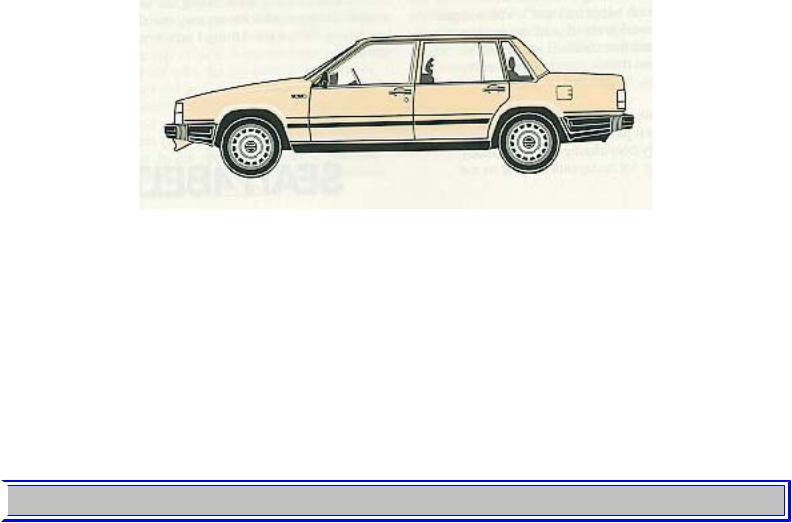
1988 Volvo 740
This Owner's manual provides information on driving and maintaining your Volvo
It should be noted that there are certain differences among model versions and market requirements; thus, you may find features described and/or pictured in this manual that do not appear on your car. Should you require more detailed information with regard to adjustments or repairs please contact your Volvo dealer.
Do not export your Volvo to another country before investigating that country's applicable safety and exhaust emission requirements. In some cases it may be difficult or impossible to comply with these requirements. Modifications to the emission control system(s) may render your Volvo not certifiable for legal operation in the U.S., Canada, and other countries.
 pg. 3 Keys
pg. 3 Keys
file:///K|/ownersdocs/1988/1988_740/88740_00.htm (2 of 3)12/30/2006 8:20:20 AM
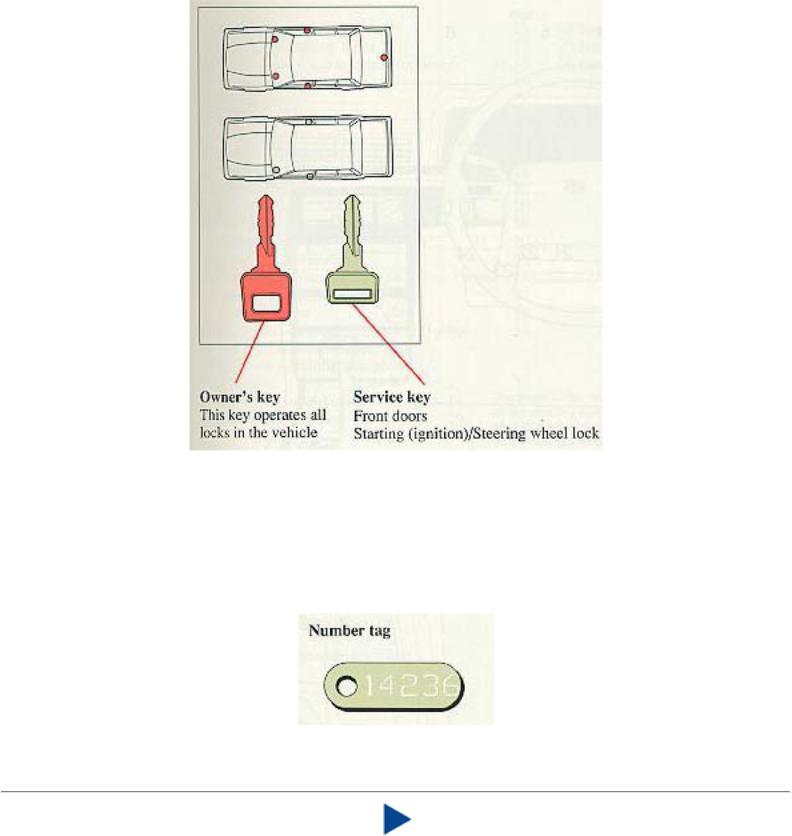
1988 Volvo 740
The key number codes are stamped on a separate tag supplied with the keys. This tag should be separated from the key ring and kept in a safe place.
The back of the tag is coated with adhesive tape.
In the event the original keys are lost, duplicates may be ordered from your Volvo dealer. The central locking system is described in detail in section "Door and locks".
Top of Page
file:///K|/ownersdocs/1988/1988_740/88740_00.htm (3 of 3)12/30/2006 8:20:20 AM
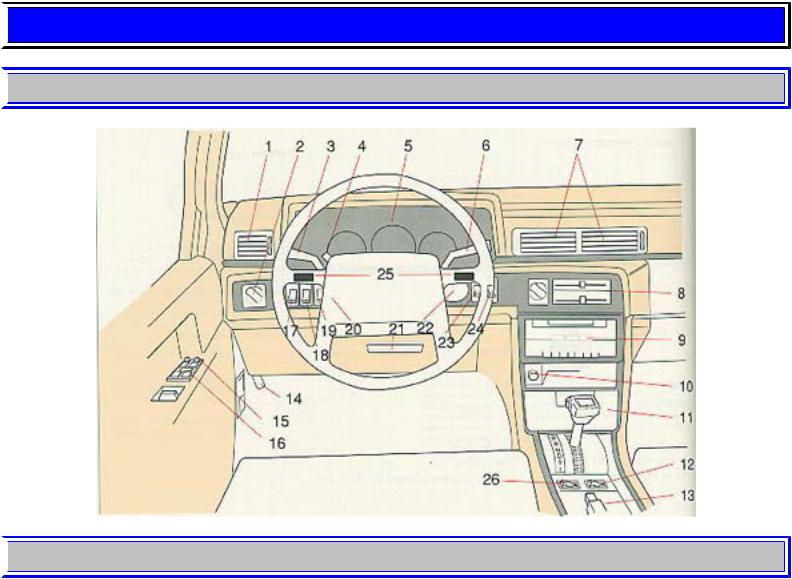
1988 Volvo 740
1 9 8 8 VOLVO 740
 Instruments and controls
Instruments and controls
 pg. 4 Instruments, Switches and controls
pg. 4 Instruments, Switches and controls
 pg. 5 Instruments, Switches and controls
pg. 5 Instruments, Switches and controls
1 |
Air louver |
20 |
2 |
Headlights, parking lights |
15 |
3 |
Turn signals. Cruise Control (optional) |
12,14 |
4 |
Hazard warning flashers |
12 |
5 |
Instruments |
6 |
6 |
Wiper/washer |
13 |
7 |
Air louvers |
20 |
file:///K|/ownersdocs/1988/1988_740/88740_01.htm (1 of 23)12/30/2006 8:20:22 AM

1988 Volvo 740 |
|
||
8 Heating and ventilation |
21- |
||
23 |
|||
|
|
||
9 Audio cassette/tuner |
20 |
||
10 |
Cigarette lighter |
18 |
|
11 |
Ash tray |
18 |
|
12 |
Electrically-heated passenger seat |
17 |
|
13 |
Parking brake |
18 |
|
14 |
Hood release handle |
35 |
|
15 |
Power door mirrors (GLE, Turbo) |
26 |
|
16 |
Electrically operated windows |
19 |
|
17 |
Rear fog lamps |
16 |
|
18 |
Fog lights (optional, standard on Turbo) |
16 |
|
19 |
Space for additional equipment |
- |
|
20 |
Space for additional equipment |
- |
|
21 |
Air louver |
20 |
|
22 |
Starting (ignition) switch/steering wheel lock 11 |
||
23 |
Electrically operated sun roof |
27 |
|
24 |
Rear window demister |
17 |
|
25 |
Horn |
- |
|
26 |
Electrically-heated driver's seat |
17 |
|
The pages in this section provide a detailed description of the vehicle's instruments and controls. Note that vehicles may be equipped differently, depending on special legal requirements, etc.
 pg. 6 Instruments
pg. 6 Instruments
file:///K|/ownersdocs/1988/1988_740/88740_01.htm (2 of 23)12/30/2006 8:20:22 AM

1988 Volvo 740
NOTE: Canadian model speedometers/odometers indicate kilometers only.
1 Voltmeter (Turbo models)
2 Fuel gauge
3 Clock reset knob
4 Quartz crystal clock
5Speedometer
6Trip odometer
7Trip odometer reset knob
8Odometer
9Tachometer
10Instrument panel lamps rheostat
11Temperature gauge
12Boost gauge (Turbo models)
 pg. 7 Instruments
pg. 7 Instruments
Quartz crystal clock
To reset the hands, push in the reset knob and turn.
Tachometer
Reads thousands of engine rpm. Engine should not be operated in red range.
Trip odometer
Used form measuring shorter distances. (last figure represents 1/10 mile or km)
Trip odometer reset knob
Push in to reset
file:///K|/ownersdocs/1988/1988_740/88740_01.htm (3 of 23)12/30/2006 8:20:22 AM

1988 Volvo 740
Temperature gauge
The pointer should be approximately midway on the gauge face when driving. If the pointer approaches the red range repeatedly, check coolant level and fan belt tension. Do not drive the car with the pointer in the red range. See sections "Coolant" and "Drive belts"
WARNING!
Allow engine to cool before adding coolant.
Fuel gauge
The fuel tank capacity is approx. 15.8 US gals (60 liters). The red range represents approx. 2.4 US gals. (9 liters). See "Refueling" for further information.
Instrument panel lamps rheostat
Clockwise = brighter.
Counterclockwise = dimmer.
Voltmeter
(Turbo-engine cars only) The voltmeter indicates the voltage in the electrical system and thereby also the state of the battery. While the car is being driven the pointer should be within the black field. Should the pointer point to the upper or lower red field when driving, this may indicate some fault in the electrical system.
Boost pressure gauge
(Turbo-engine cars only) The boost pressure gauge is divided into sections.
Black section: The engine acts as a normally-aspirated engine. Best fuel economy is achieved while driving in this range. Yellow section: The turbo is providing boost pressure.
 pg. 8 Indicator and warning lights
pg. 8 Indicator and warning lights
file:///K|/ownersdocs/1988/1988_740/88740_01.htm (4 of 23)12/30/2006 8:20:22 AM
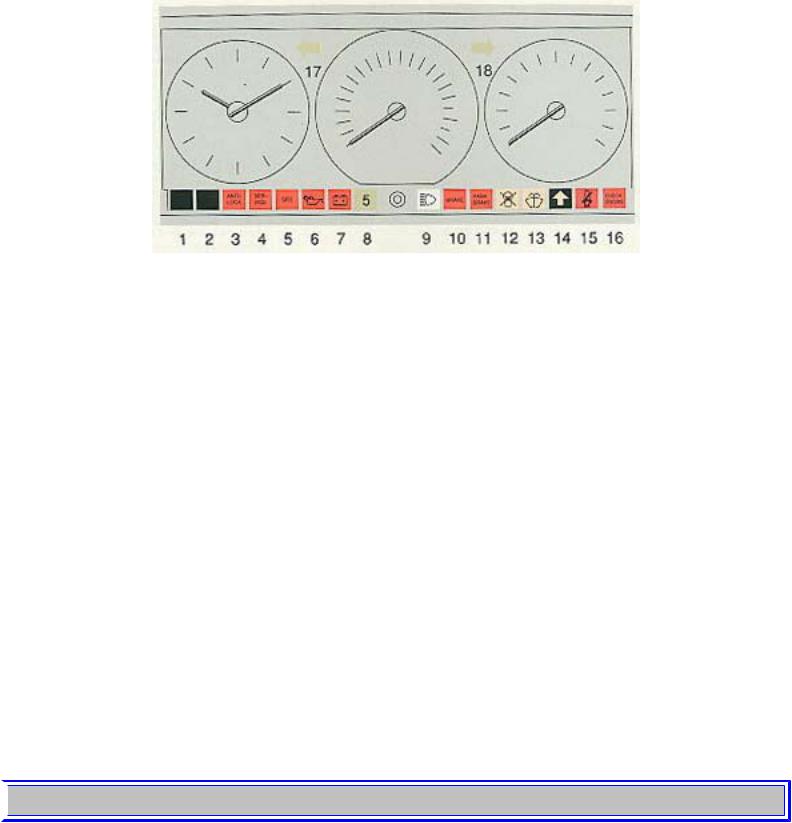
1988 Volvo 740
1 (Not in use)
2 (Not in use)
3 ABS-system, see p. 10 (Not on SRS-equipped vehicles) 4 Service reminder light, see p. 10
5 SRS malfunction light
6 Low engine oil pressure
7 Alternator not charging
8 Overdrive (5th gear) engaged (Turbo with manual transmission)
9 High beams
10 Brake failure
11 Parking brake applied
12 Bulb failure
13 Low washer fluid level.
If the lamp glows continuously when the engine is running, there is only about 1/2 - 1 US qts. remaining in the washer fluid reservoir.
14 Shift indicator light
(manual transmission models) or 4th gear disengaged, automatic transmission 15 Fasten seat belts
16 (Not in use)
17 Turn signal, left
18 Turn signal, right
 pg. 9 Warning lights
pg. 9 Warning lights
The warning lights described on this page should never stay on when driving
When the ignition key is turned on, and before the engine starts, all of the warning lights should be on to test the function of the bulbs. Should a light not go off after the engine has started, the system indicated should be inspected. However, the parking brake reminder light will not go off until the parking brake is fully released.
file:///K|/ownersdocs/1988/1988_740/88740_01.htm (5 of 23)12/30/2006 8:20:22 AM
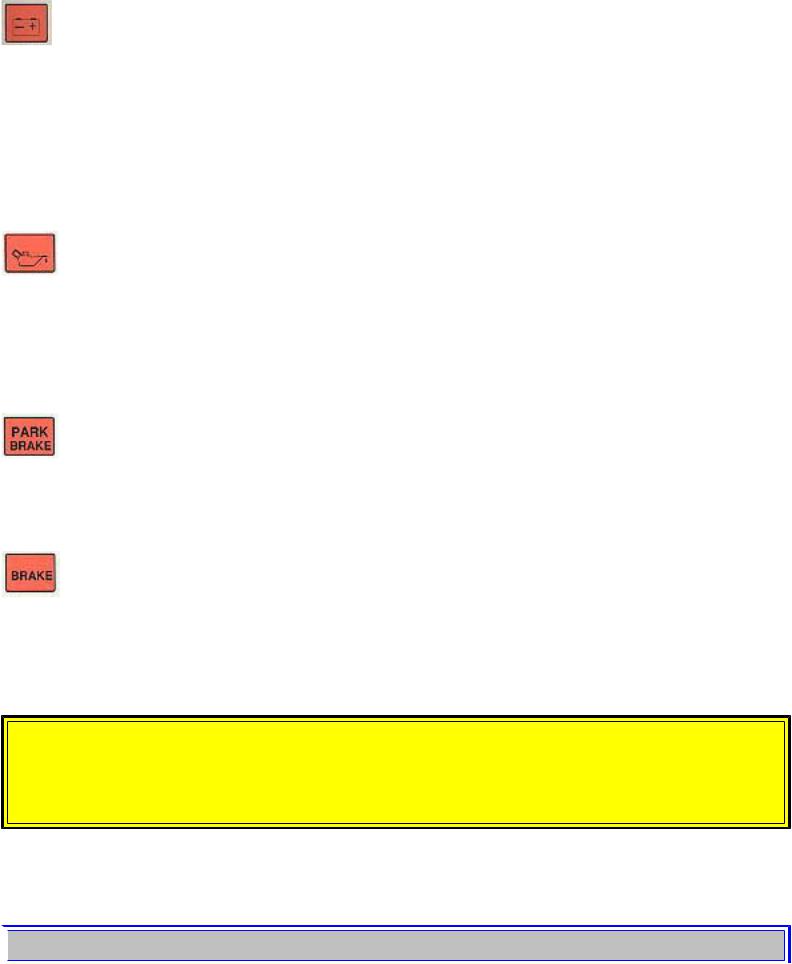
1988 Volvo 740
Alternator warning light
If the light comes on while the engine is running, check the tension of the alternator drive belt as soon as possible.
NOTE: This warning light is illuminated if the alternator is not charging. However, parking brake, brake failure and bulb failure warning lights will be illuminated at the same time due to the design of the system.
Oil pressure warning light
If the light comes on during driving, the oil pressure is too low. Stop the car and then stop the engine immediately and check the engine oil level. See section titled "Engine oil".
After hard driving, the light will come on occasionally when the engine is idling. This is normal, provided it goes off when the engine speed is increased.
Parking brake reminder light
This light will be on when the parking brake (hand brake) is applied. The parking brake lever is situated between the front seats.
Brake failure warning light
If the light comes on while driving or braking, this indicates that the brake fluid level is too low. Stop immediately, open the hood and check the brake fluid level in the reservoir (see pages 95-96 for reservoir position)!
WARNING!
If the fluid level is below the MIN mark in the entire reservoir: do not drive. Tow the car to a garage and have the brake system checked/repaired.
If the fluid level is above the MIN mark, or is below the MIN mark in only one of the two parts of the reservoir, drive with caution to an authorized Volvo dealer for inspection of the system.
 pg. 10 Indicator lights
pg. 10 Indicator lights
file:///K|/ownersdocs/1988/1988_740/88740_01.htm (6 of 23)12/30/2006 8:20:22 AM

1988 Volvo 740
Service reminder light
(except models equipped with SRS)
The light will come on at 5000 mile (8000 km) intervals. It is a reminder to the driver to have the engine oil and oil filter changed. The light will stay on 2 min. after start until reset by the servicing dealer. For resetting see section "Service diagnosis".
Anti-lock Brake System ABS
ABS brakes are designed to prevent the brakes from locking under severe braking conditions. If the light comes on while driving, there is a malfunction of the ABS system (the standard braking system will still function), and the car should be driven to an authorized Volvo dealer for inspection.
The system "senses" when the brakes begin to lock. regulates the brake pressure and thereby helps prevent the brakes from locking. When the system is activated, you may be aware of a slight vibration in the brake pedal. The switching sound of the control unit in the engine compartment may also be audible. This is quite normal.
Note that the ABS system does not increase the total braking capacity of your car. It does, however, enable you to steer and helps to retain better control of the vehicle.
Shift indicator light (Manual transmission cars only)
The Volvo shift indicator light (S.I.L.) is a device designed to help you get even better gas mileage from your Volvo car. Studies have shown that the best fuel economy is obtained by shifting gears at low engine rpm and high relative engine load. The Volvo S.I.L. is calibrated to show you when to shift for improved mileage without sacrificing smooth acceleration.
Use of the S.I.L. is simple. Shift to the next higher gear as soon as the light comes on. You may find after using the S.I.L. for some time that your natural shifting rhythm will adapt to the S.I.L's suggestion. Some drivers may even shift before the light comes on.
Obviously, there will be times when you need to shift later than the light would indicate, for example. when climbing hills or trailer towing. Using the light regularly, however, should result in a mileage improvement of six percent or more. depending on how you normally drive.
SRS Supplemental Restraint System (optional on certain models)
If the light comes on (or stays on after the vehicle has started, the SRS diagnostic system has detected a fault. Drive to an authorized Volvo dealer for inspection. (See section "SRS" for further information.)
file:///K|/ownersdocs/1988/1988_740/88740_01.htm (7 of 23)12/30/2006 8:20:22 AM
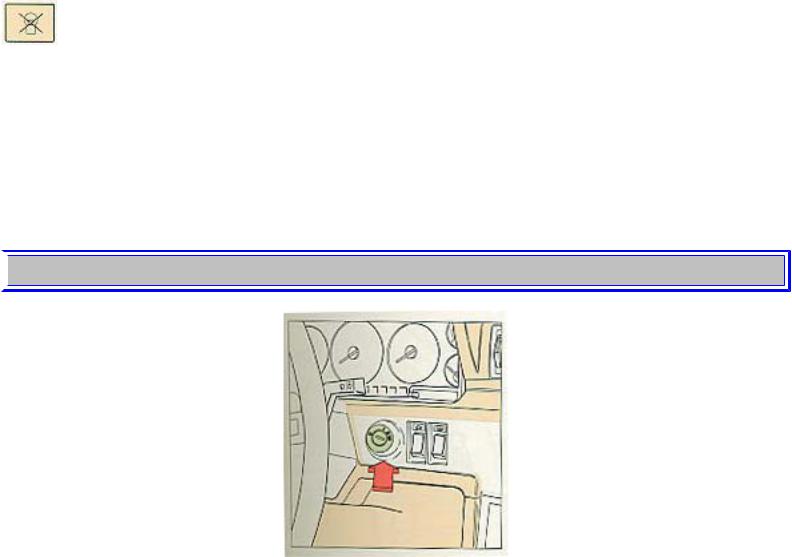
1988 Volvo 740
Programming instructions for shift indicator
If the current supply to the control unit is cut (battery disconnected), the control unit will have to be reprogrammed as the control unit memory will be erased.
Drive the car in each gear, first gear not necessary, for approximately 8 seconds.
The gear change indicator light will flicker once (0.5 seconds), as each gear is programmed.
NOTE: Remove the foot completely from the clutch pedal after each gear change when programming the control unit.
Bulb failure warning light
The light will come on if any of the following bulbs are defective: one of the low beam headlights
one of the tail lights
one of the brake lights when the brake pedal is depressed.
Check the fuse and bulb. See sections titled "Replacing bulbs" and "Fuses".
Should the warning light come on after a defective outside bulb has been replaced, the corresponding bulb on the other side of the car should also be replaced.
 pg. 11 Starting (ignition) switch
pg. 11 Starting (ignition) switch
Starting (ignition) switch/steering wheel lock
The steering wheel lock might be under tension when the car is parked. Turn the steering wheel slightly to free the ignition key.
A chime will sound if the starting key is left in the ignition lock and front door on the driver's side is opened.
file:///K|/ownersdocs/1988/1988_740/88740_01.htm (8 of 23)12/30/2006 8:20:22 AM
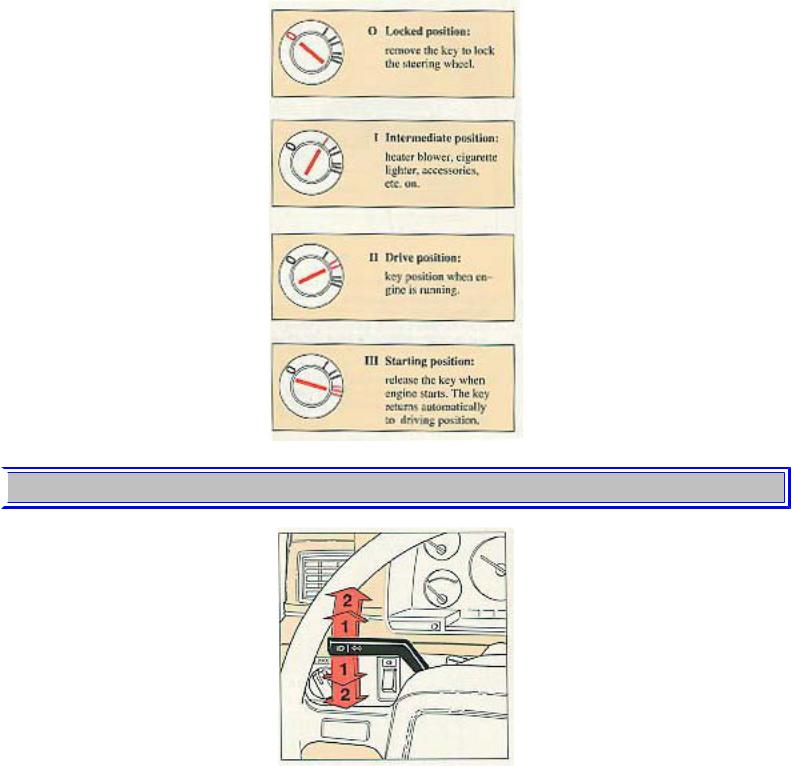
1988 Volvo 740
 pg. 12 Turn signals, Hazard warning flasher
pg. 12 Turn signals, Hazard warning flasher
Turn signals
1 Lane change position. In maneuvers such as lane changing, the driver can flash the turn signals by moving the turn signal lever to the First stop and holding it there. The lever will return to the neutral position when released.
2 Signal lever engaged for normal turns.
NOTE: Defective turn signal bulb will cause turn signal indicator and remaining signal lights to flash
file:///K|/ownersdocs/1988/1988_740/88740_01.htm (9 of 23)12/30/2006 8:20:22 AM
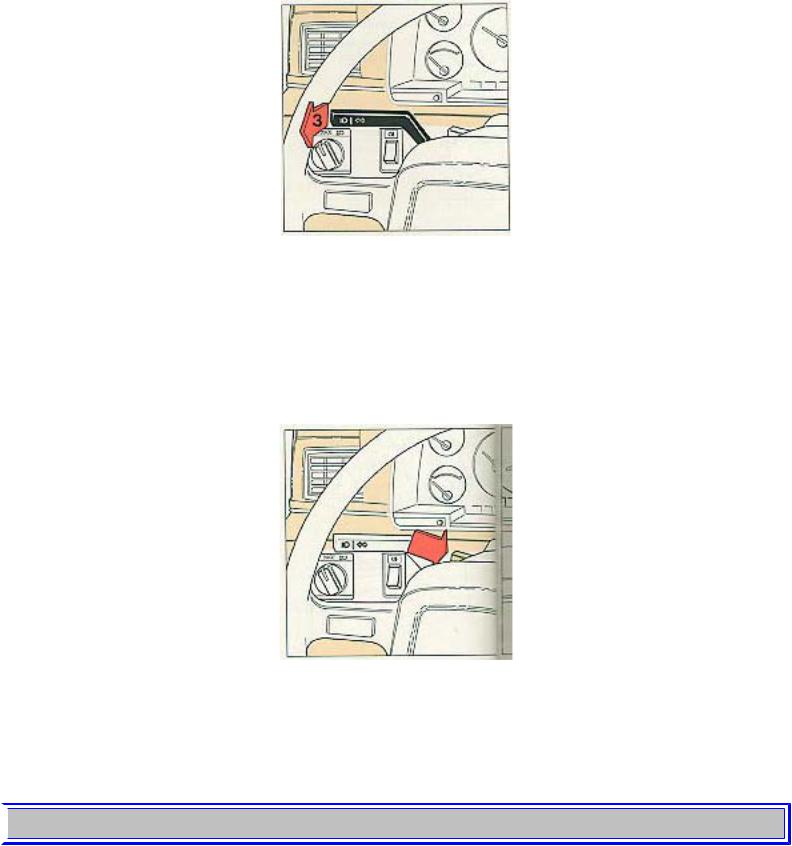
1988 Volvo 740
more rapidly than normal.
3 High beam/low beam switch (headlights on).
Move the lever towards the steering wheel past the headlight flasher position and release it.
3 Headlight flasher (headlights off).
Move the lever towards the steering wheel. The headlight high beam will be on until the lever is released.
Hazard warning flasher
The four-way flasher should be used to indicate that the vehicle has become a traffic hazard.
NOTE: Regulations regarding the use of the hazard warning flasher may vary from state to state.
 pg. 13 Windshield, Tailgate wipers/washers
pg. 13 Windshield, Tailgate wipers/washers
file:///K|/ownersdocs/1988/1988_740/88740_01.htm (10 of 23)12/30/2006 8:20:22 AM

1988 Volvo 740
Wiper/washer
1 Intermittent wiper.
With switch in this position, the wipers will sweep approximately every seventh second.
2 "Single sweep" position.
Switch returns automatically when released.
3 Wipers, low speed.
4 Wipers, high speed.
5 Windshield wiper/washer.
The wiper will make 2-3 complete sweeps after the lever is released.
Tailgate window wiper/washer (wagon)
The tailgate window wiper/washer is operated by a switch at the end of the wiper lever.
1 The wiper operates continuously.
2 Intermittent position: the wiper strokes approximately every 10 seconds.
3 Tailgate washer.
After the button is released the wiper strokes 2-3 additional times before stopping.
The electrical circuit is protected by fuse 14, located in the central electrical unit. See the section entitled
file:///K|/ownersdocs/1988/1988_740/88740_01.htm (11 of 23)12/30/2006 8:20:22 AM
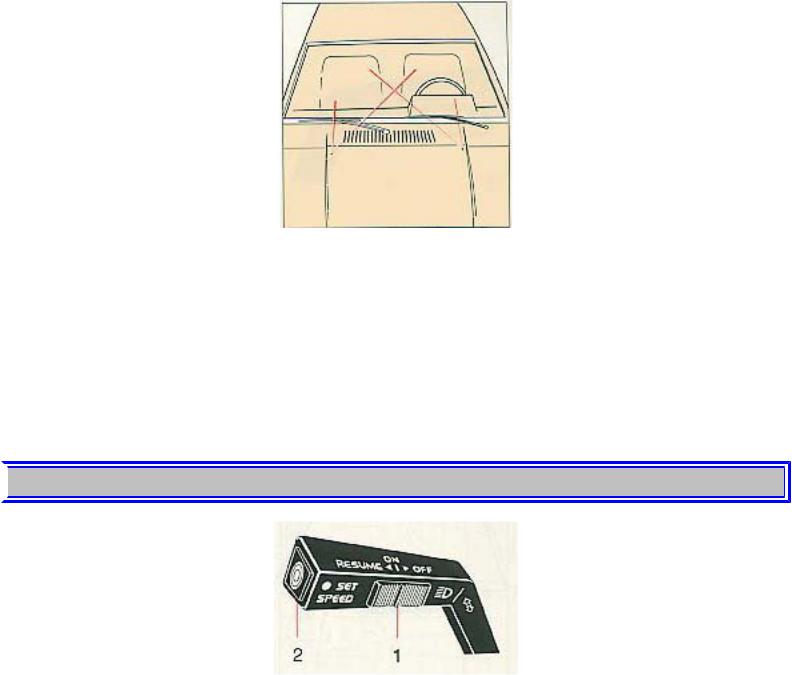
1988 Volvo 740
"Fuses".
Adjusting washer nozzles
The washer jets should spray the windshield as shown. Use the edge of a small screwdriver to adjust the nozzles, if necessary.
Washer fluid reservoir
The washer fluid reservoir is located in the engine compartment and holds approx. 0.5 US gal. (2.0 liters) on sedan models and approx. 0.8 US gal (3.2 liters) on wagon models.
During cold weather, the reservoir should be filled with windshield washer solvent.
 pg. 14 Cruise control
pg. 14 Cruise control
Cruise control
(optional on certain models)
The cruise control switches are located on the turn signal switch lever.
To engage and set desired speed:
1.Set switch (1) to ON.
2.Accelerate to desired cruise speed.
NOTE: The cruise control cannot be engaged at speeds below 22 mph (35 km).
file:///K|/ownersdocs/1988/1988_740/88740_01.htm (12 of 23)12/30/2006 8:20:22 AM
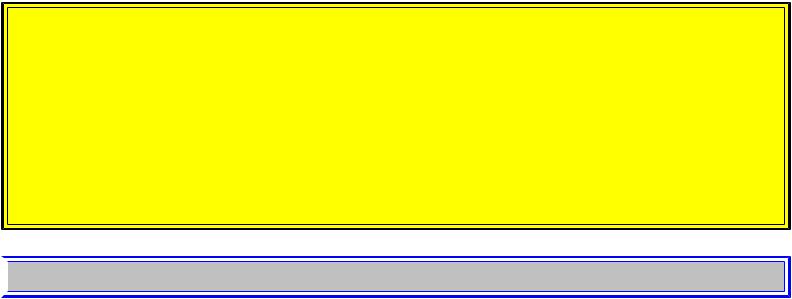
1988 Volvo 740
3. Depress SET SPEED switch (2).
Operating brake pedal or clutch pedal (where applicable)
This will automatically disengage the cruise control. Previously selected cruise speed is retained in the memory and by momentarily setting the switch to RESUME position that speed will be re-engaged.
NOTE!
The vehicle will accelerate very quickly should there be a substantial speed differential when the switch is reset that the vehicle be accelerated manually and the switch reset to RESUME once the speed differential has been reduced.
Acceleration
Momentary acceleration, such as for passing, does not interrupt cruise control operation. The previously selected speed will be maintained without having to set switch to RESUME.
To disengage the cruise control system:
set switch (1) to position OFF, or depress brake pedal, or depress clutch pedal (where applicable). Switching off the starting (ignition) switch will automatically disengage the cruise control system.
WARNING!
The cruise control should not be used in heavy traffic or when driving on wet or slippery roads.
If the gear shift is moved to Neutral while the cruise control is engaged, then depress the brake pedal momentarily, or set the cruise control switch (1) to OFF. This will disengage the cruise control and prevent overreving the engine.
NOTE: When driving on a grade, actual vehicle speed may vary slightly from the set cruise control speed.
 pg. 15 Lighting
pg. 15 Lighting
file:///K|/ownersdocs/1988/1988_740/88740_01.htm (13 of 23)12/30/2006 8:20:22 AM
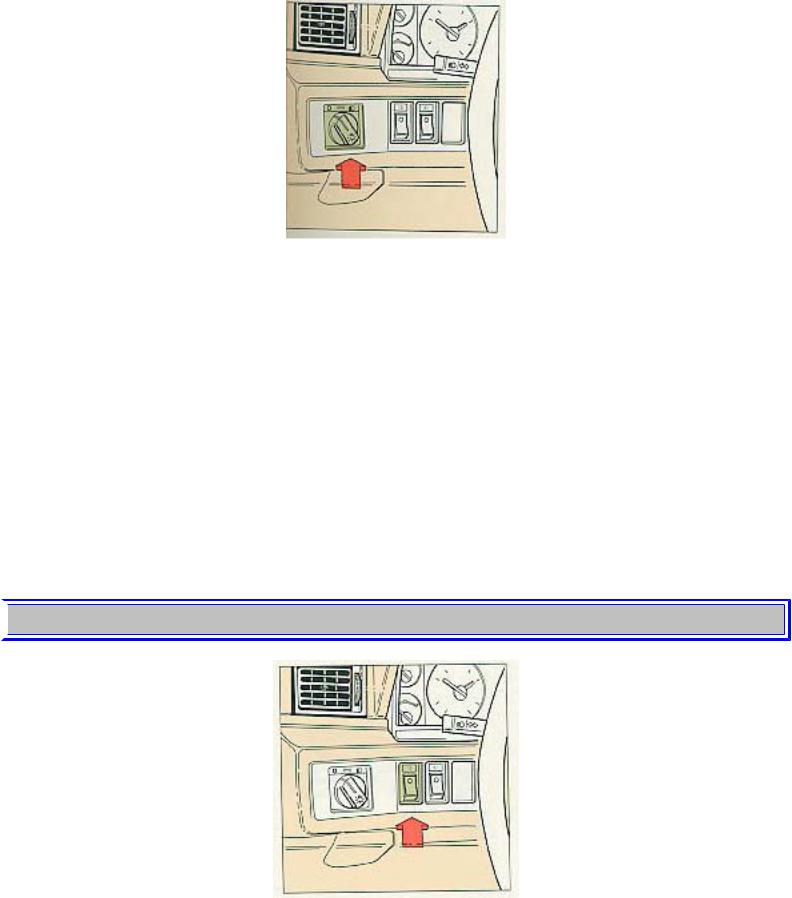
1988 Volvo 740
Headlights and position lights
 All lights off
All lights off
 Parking lights on
Parking lights on
 Headlights and parking lights are on if starting (ignition) switch is in position I or II.
Headlights and parking lights are on if starting (ignition) switch is in position I or II.
If the headlight switch is in position  all lights will go out when starting switch is switched off.
all lights will go out when starting switch is switched off.
With the headlight switch in position  the parking lights will stay on. Switch from high to low beams, and vice versa, by moving the turn signal switch lever on the left side of the steering column towards the steering wheel.
the parking lights will stay on. Switch from high to low beams, and vice versa, by moving the turn signal switch lever on the left side of the steering column towards the steering wheel.
 pg. 16 Rear fog lights, Front fog lights, Power antenna
pg. 16 Rear fog lights, Front fog lights, Power antenna
Rear fog lights
The rear fog lights are considerably brighter than the normal tail lights and should be used only when
file:///K|/ownersdocs/1988/1988_740/88740_01.htm (14 of 23)12/30/2006 8:20:22 AM

1988 Volvo 740
atmospheric conditions, such as fog, rain, snow, smoke or dust reduce the daytime or nighttime visibility of other vehicles to less than 500 ft. (152 meters). The headlights must be switched on.
Note that local regulations governing the use of these lights may vary.
Auxiliary front fog lights (optional on certain models)
Auxiliary front fog lights can be switched on only with the low-beam headlights on.
Power antenna
The power antenna switch can be used to retract the antenna when the audio system is turned on. This will permit operation of the cassette drive with the antenna in the down position.
CAUTION: Always lower the antenna when entering a garage or car wash to avoid antenna damage.
 pg. 17 Rear window demister, Heated front seats
pg. 17 Rear window demister, Heated front seats
file:///K|/ownersdocs/1988/1988_740/88740_01.htm (15 of 23)12/30/2006 8:20:22 AM
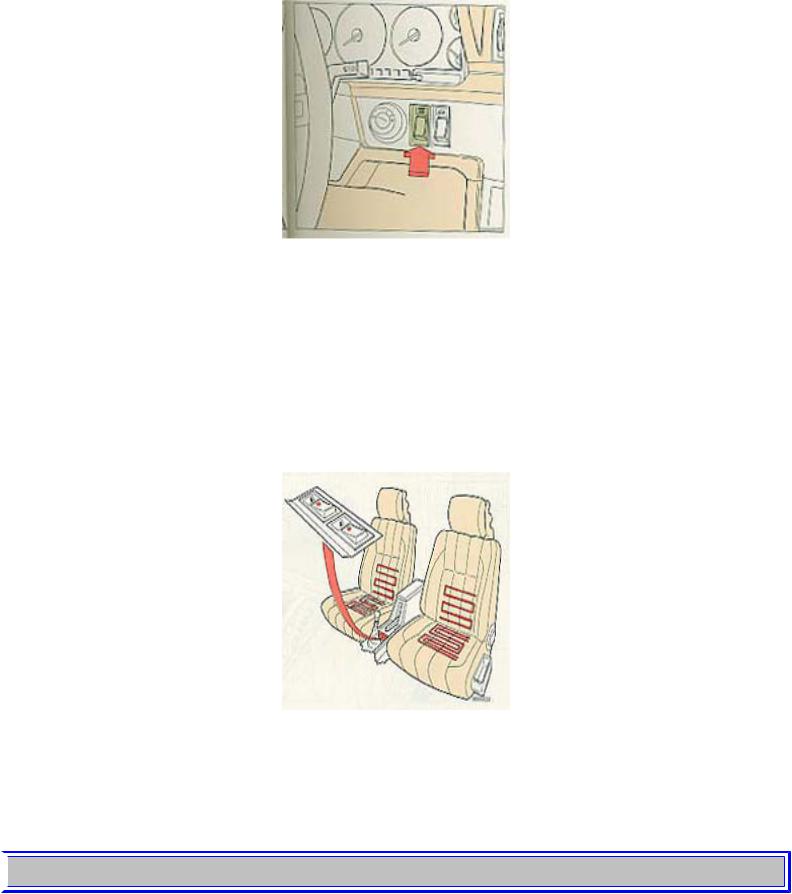
1988 Volvo 740
Rear window demister
To operate, depress the switch. The indicator lamp in the switch will come on. The system will be switched off automatically after 10-15 minutes or when the starting (ignition) key is switched off.
Heated front seats
The front seats are equipped with electrically-heated backrests and seat cushions. The heating is thermostatically-controlled and cuts out automatically. Use the switches to disengage the seat heating manually when the seat is not occupied.
Extra heating (certain models)
The switch has two positions, one for normal heating and one for extra heating. Right position = normal heating
Left position = extra heating
 pg. 18 Parking brake, Cigarette lighter, Ash trays
pg. 18 Parking brake, Cigarette lighter, Ash trays
file:///K|/ownersdocs/1988/1988_740/88740_01.htm (16 of 23)12/30/2006 8:20:22 AM
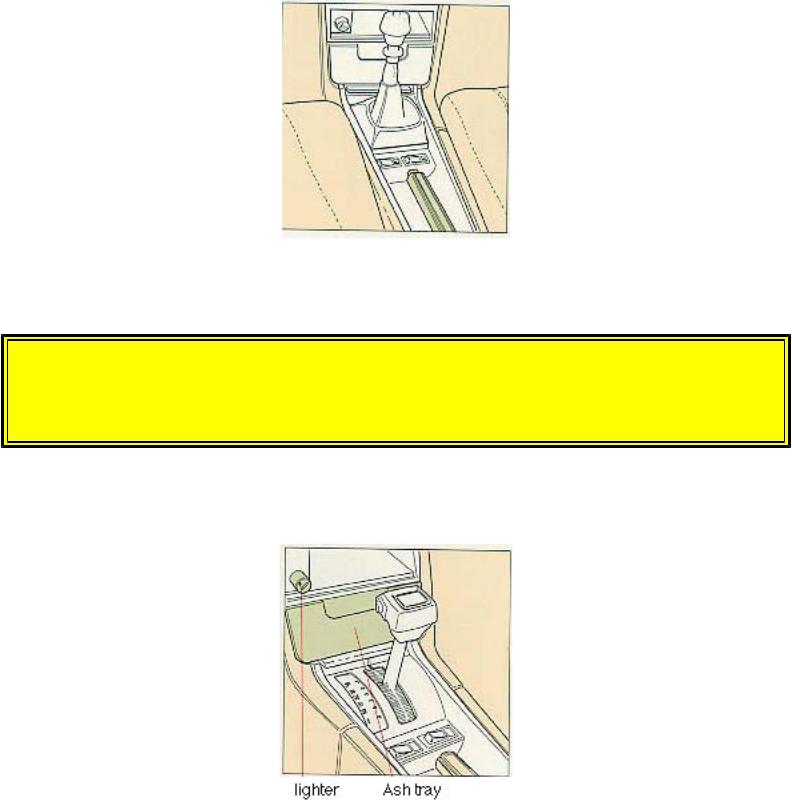
1988 Volvo 740
Parking brake (hand brake)
The lever is situated between the front seats. The brake is applied to the rear wheels.
WARNING!
Always use the parking brake (hand brake) when parking. On hills, also turn the front wheels toward the curb.
In order to obtain the best possible performance of the parking brake, the brake linings should be broken in. See section titled "Brake system".
Cigarette lighter
To operate, depress the knob fully. When the knob automatically releases, the cigarette lighter is ready for use.
The starting (ignition) switch must be switched on (to position I or II) for the cigarette lighter to function.
file:///K|/ownersdocs/1988/1988_740/88740_01.htm (17 of 23)12/30/2006 8:20:22 AM
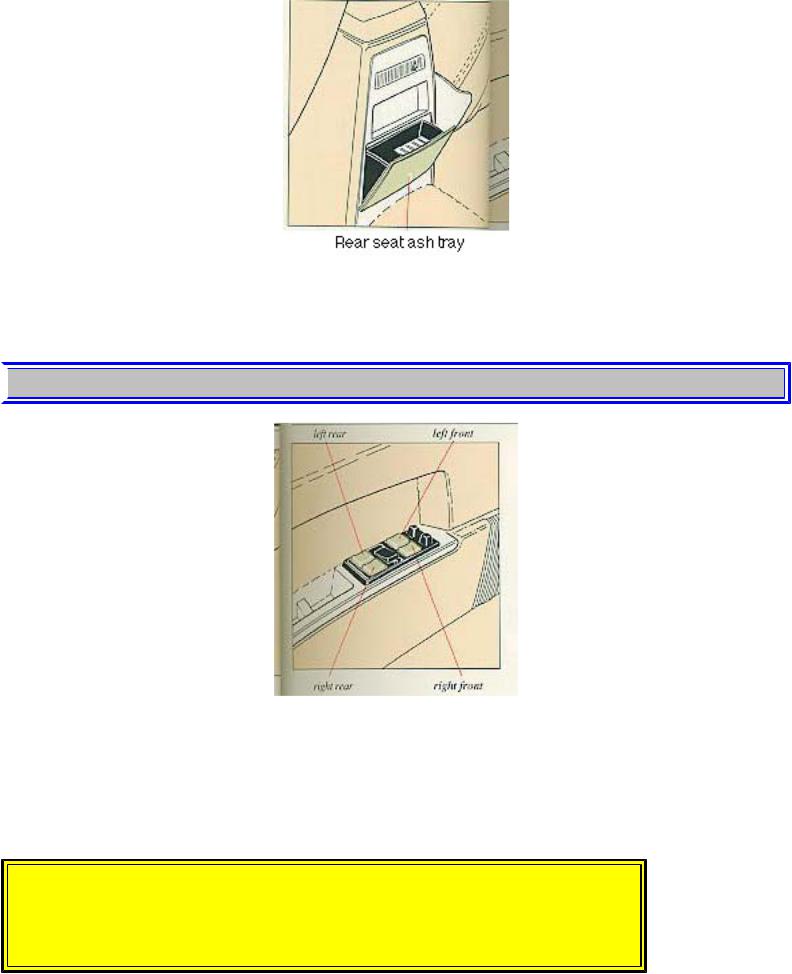
1988 Volvo 740
Ash trays
To remove the ash trays depress the center spring and remove.
 pg. 19 Electrically operated windows
pg. 19 Electrically operated windows
Electrically-operated windows (GLE, Turbo models)
The electrically operated windows are controlled by switches from the driver's armrest as shown in the above illustration. The starting (ignition) switch must be ON (position II) for the electrically operated windows to function. The window is lowered if the rear part of the switch is pressed and raised if the front part of the switch is pressed.
WARNING!
Remove the starting (ignition) key when children are left unattended in the vehicle.
file:///K|/ownersdocs/1988/1988_740/88740_01.htm (18 of 23)12/30/2006 8:20:22 AM
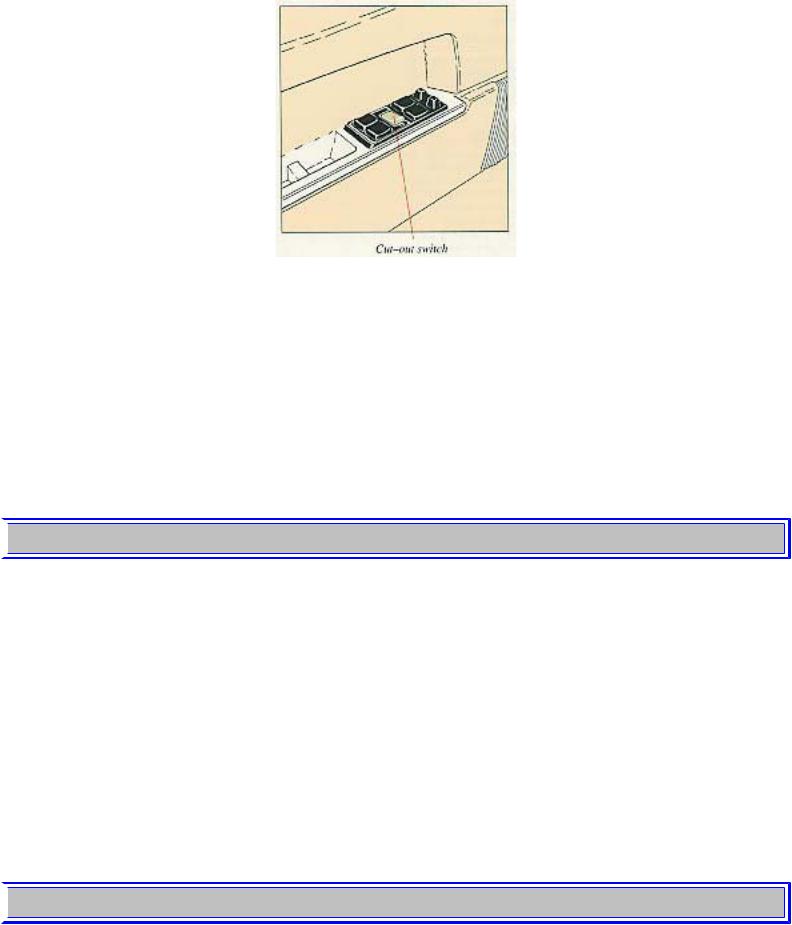
1988 Volvo 740
Cut-out switch for electrically-operated rear-door windows
If the car is equipped with rear door power windows, this function can be disabled by a switch located on the driver's door armrest. This switch is positioned 90° in relation to the other switches.
 The rear door windows can be raised or lowered with the respective door switch as well as the switch on the driver's door.
The rear door windows can be raised or lowered with the respective door switch as well as the switch on the driver's door.
 The rear door windows cannot be raised or lowered with the respective door switch but instead only with the corresponding switch on the driver's door.
The rear door windows cannot be raised or lowered with the respective door switch but instead only with the corresponding switch on the driver's door.
 pg. 20 Audio Cassette/Tuner controls and indicators
pg. 20 Audio Cassette/Tuner controls and indicators
Controls and indicators
For complete operating instructions, maintenance guidelines, and specifications, please consult your Audio Cassette/Tuner Instruction Booklet. The Booklet also contains information on radio reception and the radio antenna.
Multipath distortion
FM signals are typically "line-of-sight" and very reflective. Their reflectivity to objects such as buildings, mountains or even other passing vehicles causes the condition known as multipath distortion. This distortion is the result of the reflected signal and the direct signal reaching your antenna at slightly different times causing a cancellation of all signals. This condition will sound like hissing or static. Very little can be done to eliminate this problem, however, lowering the treble on your radio could help mask these disturbances thereby allowing you to achieve optimum pleasure from your audio system.
 pg. 21 Heating and ventilation
pg. 21 Heating and ventilation
file:///K|/ownersdocs/1988/1988_740/88740_01.htm (19 of 23)12/30/2006 8:20:22 AM

1988 Volvo 740
Heating and ventilation
Your Volvo is equipped with a heating system combined with air conditioning.
Depending on which function you select, warm of cool/cold air is distributed to the different parts of the passenger compartment. An additional driver's air louver is located beneath the steering column and can be adjusted upwards, downwards, or closed as desired.
Air louvers (dash)
AOpen
BClosed
CDirecting air flow horizontally
DDirecting air flow vertically
A certain amount of air will always enter through the dash air louvers as long as they are open, independently of the position of the air distribution control.
Close the dash air louvers to obtain maximum air flow to floor or windshield.
 pg. 22 Heating and ventilation
pg. 22 Heating and ventilation
Heating and ventilation with air conditioning
file:///K|/ownersdocs/1988/1988_740/88740_01.htm (20 of 23)12/30/2006 8:20:22 AM
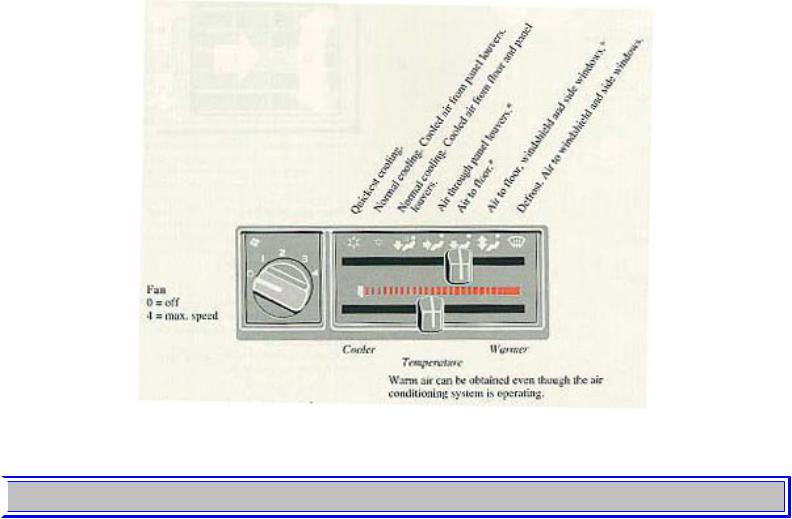
1988 Volvo 740
* Air conditioning unit not engaged.
 pg. 23 Heating and ventilation
pg. 23 Heating and ventilation
file:///K|/ownersdocs/1988/1988_740/88740_01.htm (21 of 23)12/30/2006 8:20:22 AM
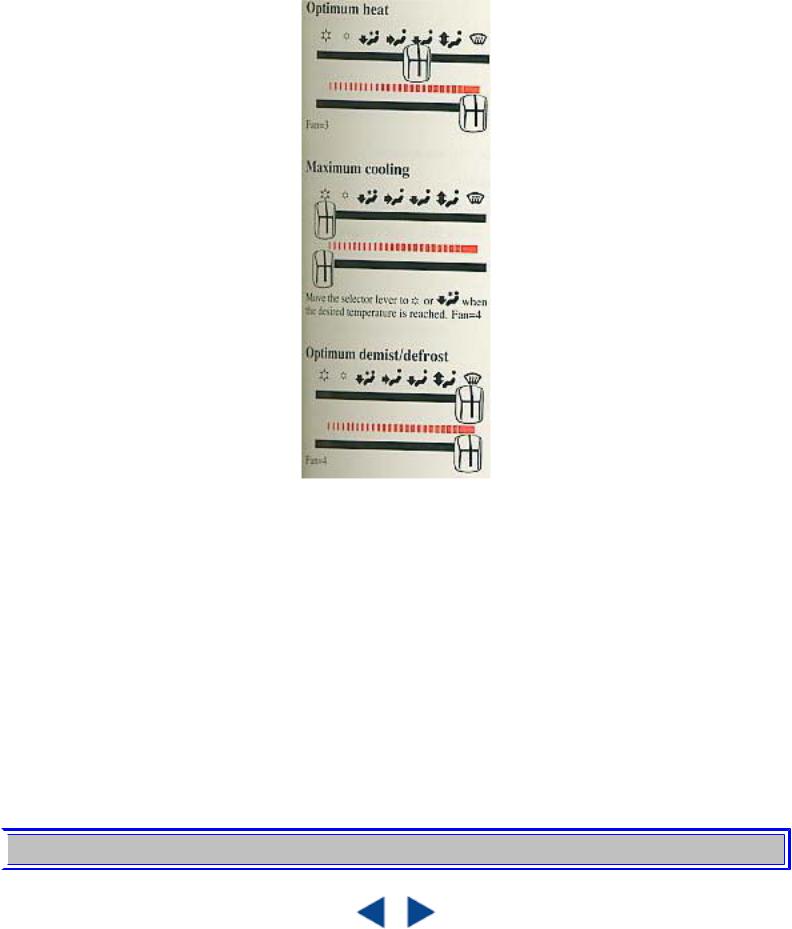
1988 Volvo 740
Additional information and tips
●The air conditioning compressor is engaged only if the temperature is above 46°F (+8°C).
●In all three air conditioning positions the fan runs at speed 1 if the switch is at "0". This is a safety measure to prevent formation of ice in the system.
●When the outside air is contaminated with exhaust gases, smoke, etc. (as when driving through a tunnel), move the lever to  for a few minutes. In this position very little air is drawn in to the
for a few minutes. In this position very little air is drawn in to the
passenger compartment from outside. Do not, however, leave the lever in this position for more than 1015 minutes, since hardly any fresh air is being supplied.
Regulate the temperature with the temperature control lever. ● The air conditioning unit functions best if used regularly.
Always keep the air inlet grill in front of the windshield clear of snow in winter.
 pg. 24
pg. 24
file:///K|/ownersdocs/1988/1988_740/88740_01.htm (22 of 23)12/30/2006 8:20:22 AM

1988 Volvo 740
Contents | Top of Page
file:///K|/ownersdocs/1988/1988_740/88740_01.htm (23 of 23)12/30/2006 8:20:22 AM

1988 Volvo 740
1 9 8 8 VOLVO 740
 Body and interior
Body and interior
 pg. 25 Body and interior
pg. 25 Body and interior
The seats, seat belts, doors, etc. are described on the following pages.
Rear-view/side-view mirrors |
26 |
Interior light, sun roof |
27 |
Front seats |
28 |
Child safety |
29 |
Seat belts |
30 |
Doors and locks |
32 |
Trunk, long load storage |
34 |
Hood |
35 |
Passenger compartment, storage spaces |
36 |
Station wagon tailgate, storage spaces |
37 |
Folding rear seat (wagon) |
39 |
Cargo space lighting, spare tire, jack (wagon) 41
 pg. 26 Rear/side-view mirrors
pg. 26 Rear/side-view mirrors
file:///K|/ownersdocs/1988/1988_740/88740_02.htm (1 of 23)12/30/2006 8:20:23 AM
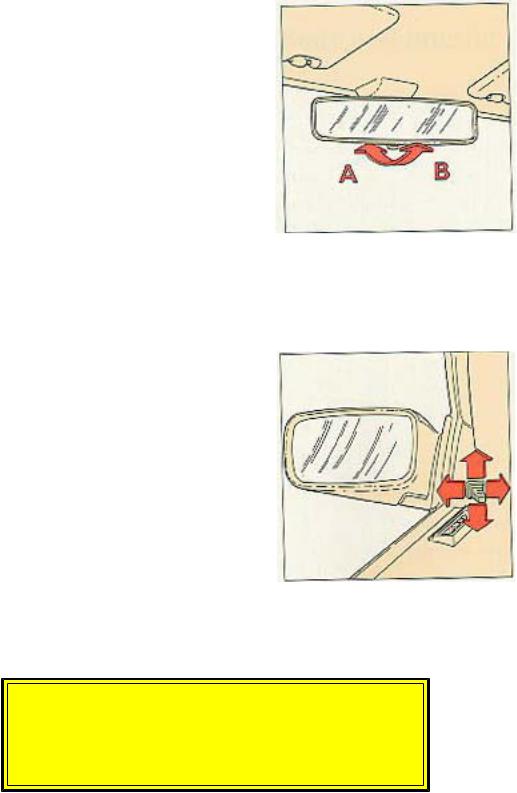
1988 Volvo 740
Rear-view mirror
A Normal position
B Night position, reduces glare from following headlights
Side-view mirrors
Use the lever to adjust.
WARNING!
The mirrors should always be adjusted before driving.
file:///K|/ownersdocs/1988/1988_740/88740_02.htm (2 of 23)12/30/2006 8:20:23 AM
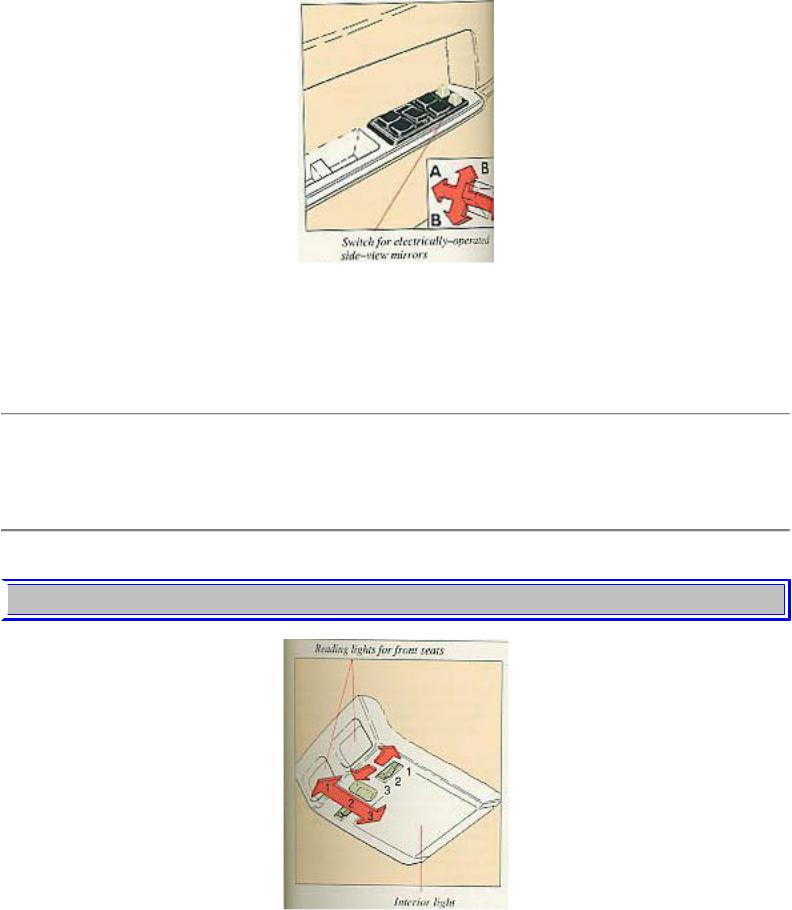
1988 Volvo 740
Electrically-operated side-view mirrors
The control switches are located in the driver's door armrest.
A Adjustment sideways
B Adjustment up/down
CAUTION:
Never use ice scrapers made of metal as they can easily scratch the mirror surface.
 pg. 27 Interior light, Sun roof
pg. 27 Interior light, Sun roof
Interior light
file:///K|/ownersdocs/1988/1988_740/88740_02.htm (3 of 23)12/30/2006 8:20:23 AM
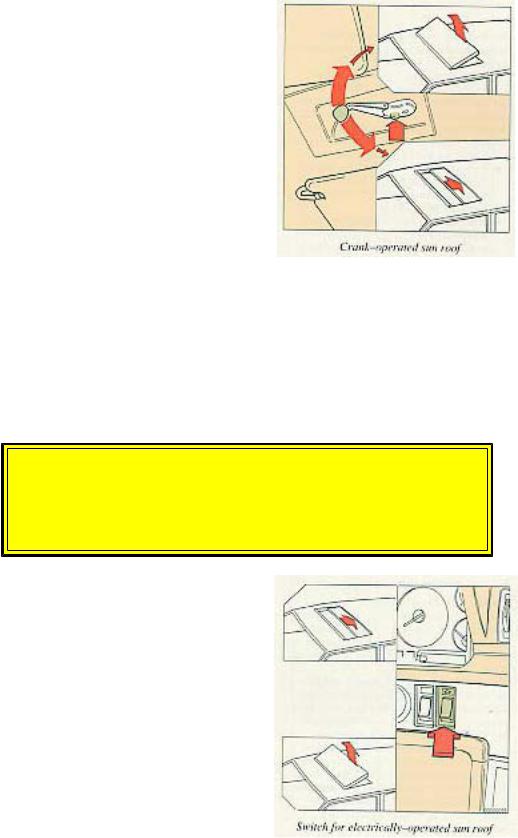
1988 Volvo 740
1.Light always on.
2.Light always off.
3.Light is on when either of the front or rear doors are opened.
Sun roof (certain models)
The sun roof can be used in two ways: as a conventional sliding roof, or the rear edge can be raised or lowered to provide various ventilation positions.
1 Depress the button prior to cranking.
2 Counter-clockwise: sliding roof.
3 Clockwise; ventilation positions.
WARNING!
For added safety, always have the crank folded during driving.
file:///K|/ownersdocs/1988/1988_740/88740_02.htm (4 of 23)12/30/2006 8:20:23 AM
